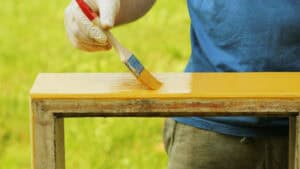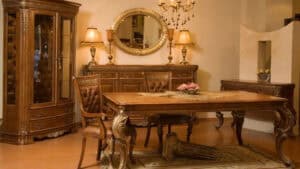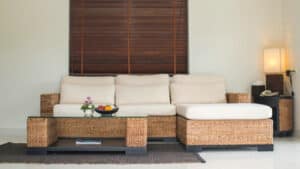
A wooden table is a timeless and versatile piece of furniture that can anchor any dining space, from a cozy breakfast nook to a formal dining room. Whether you have a rustic farmhouse table, a sleek modern design, or a classic traditional style, the right placemats can enhance both the look and functionality of your wooden table. Like other tablecloths, placemats not only protect the tabletop from hot dishes, stains, spills, and wear, but they also add color, texture, and style to your table setting.
In this article, we’ll explore the various types of placemats that pair well with wooden tables, offering tips and inspiration to help you create a dining setting that’s both stylish and welcoming. Whether you’re setting the table for a casual family meal or hosting a formal dinner party, the right placemats can elevate your wooden table and make interior design feel special.
How to Choose a Suitable Placemat
When selecting the perfect table mat, there are three things you should carefully consider: the size, material, and style. These factors will determine not only the aesthetics but also the functionality of your table setting.
What are the common sizes of placemats?
- Circular: Typically ranging from 12 to 14 inches in diameter.
- Rectangular: Standard sizes are often 12 x 18 inches or larger at 14 x 20 inches.
- Square: Common dimensions include 14 x 14 inches or 12 x 12 inches for large squares.
What are the main styles of place mats?
Based on the search results, there are several main styles and types of placemats:
- Material-based styles:
- Cotton, polyester, silk, lace, canvas, wool placemats
- Vinyl, silicone, leather, cork placemats
- Bamboo, paper, poster board, foam placemats
- Woven placemats made of materials like seaweed and jute
- Wooden placemats including laminated wood and untreated wood
- Metal placemats
- Design-based styles:
- Solid colored placemats in various materials
- Patterned, printed, or embroidered placemats
- Placemats with special borders like piping or fringe
3. Aesthetic styles:
- Casual, rustic style placemats like woven or wooden mats
- Elegant, formal placemats like lace, silk or linen
- Modern, contemporary style placemats in sleek materials or designs
- Southwestern or Mexican serape-style woven placemats
How to Choose the Right Placemats for Your Wooden Table
Choosing the right placemats for your wooden table can enhance the overall ambiance of your dining area. Pay attention to color harmony, design patterns and textures, and shape and size to compliment your table’s natural beauty and decor style.
Color Harmony with Wooden Tables
When selecting placemats, consider colors that harmonize with the tone of your wood. For a light wood table, soft pastel shades like buttery yellow or pale peach can create a warm and inviting look. If your table is dark wood, richer colors or elegant neutrals can offer a striking contrast without overwhelming the natural grain of the wood.
- Light Wood Table:
- Pastels: Soft yellow, powder blue, peach
- Neutrals: Beige, light gray, ivory
- Dark Wood Table:
- Rich tones: Burgundy, navy blue, emerald green
- Elegant neutrals: Charcoal, chocolate brown, black
Design Patterns and Textures

Your placemats can be a reflection of your personality and help set the mood for meals. Modern geometric patterns add a contemporary touch, while floral and lace designs can provide a more traditional or romantic feel. When it comes to textures, consider ones that complement rather than compete with wood. Linen, burlap, and cotton are great for a more natural look, whereas materials like leather can add sophistication.
- Contemporary Style
- Patterns: Geometric, stripes, abstract
- Textures: Smooth cotton, leather, synthetic fibers
- Traditional Style
- Patterns: Floral, paisley, damask
- Textures: Linen, lace, quilted fabric
Here are some recommendations for choosing the best placemat for you home:
For formal dining tables made of dark, rich woods like mahogany or cherry:
- Elegant placemats made of materials like jacquard, linen, or high-quality cotton in solid colors or subtle patterns will enhance the formal look
- Avoid overly casual materials like plastic or bright, bold patterns that clash with the sophisticated wood
For rustic, farmhouse style tables made of distressed or reclaimed wood:
- Woven placemats made of natural fibers like rattan, jute, or seagrass will complement the rustic vibe
- Wooden beaded placemats or cork placemats also pair well and add natural texture
For modern, minimalist tables made of light woods like ash or blonde oak:
- Simple, solid-colored placemats in neutral tones or black and white will maintain a clean, contemporary look
- Placemats with geometric patterns can also work well if they match the modern aesthetic
For traditional tables made of classic woods like oak or walnut:
- Placemats with traditional patterns like damask or toile in muted colors will suit the conventional style
- Lace placemats or those with decorative embroidered edges also complement traditional wooden tables
For outdoor wooden tables like picnic or patio tables:
- Opt for durable, weather-resistant placemat materials like vinyl, bamboo or plastic
- Rigid materials like slate can also work well as outdoor placemats on wooden tables
Frequently Asked Questions
What are the best placemats for a round table?
The key is choosing placemats that complement the shape of your round table, provide ample space for each place setting, and reflect your personal style – whether that’s casual and natural, elegant and formal, or modern and easy-care.
What materials are most suitable for placemats on a wooden dining table?
Natural materials such as cotton, linen, and seagrass offer both aesthetic appeal and functionality. Vinyl is a practical choice for water resistance, while materials like woven cotton are easily washable and can provide subtle texture.
Are there specific placemats that are recommended for protecting a wooden table from heat?
Placemats made of heatproof materials like seagrass and thick cotton are the best materials that can protect your wooden table from hot dishes. Look for options labeled as heat-resistant or those rated for higher temperatures to ensure adequate protection.
In terms of style, what should my placemats match with at my dining area?
Your placemats should generally complement the decor of your dining area including the tableware and the overall color scheme. If your dining area features a minimalist design, choose simple, solid-colored placemats. For more vibrant spaces, patterned placemats can add visual interest.
Is it necessary to use placemats on a wooden table, and what are the benefits?
While not necessary, placemats offer benefits such as protecting your table surface from scratches, heat damage, and spills. They also add a layer of decor and can make cleanup easier after meals.
What are the latest trends in placemats for those who want to be stylish on tables?
Trends in placemats include eco-friendly materials and artisanal craftsmanship. Natural textures and minimalist designs are popular, as well as bold colors and patterns that make a statement. Look for placemats that align with sustainable practices and contemporary design trends.
How do I choose the best placemat for different occasions?
When curating the perfect dining experience, it’s pivotal to consider both the setting and the event. For formal events, lean towards elegant materials, subtle colors, and refined details. For casual get-togethers, embrace color, pattern and durable, easy-care materials. The key is selecting placemats that set the right tone and style for the dining occasion.






